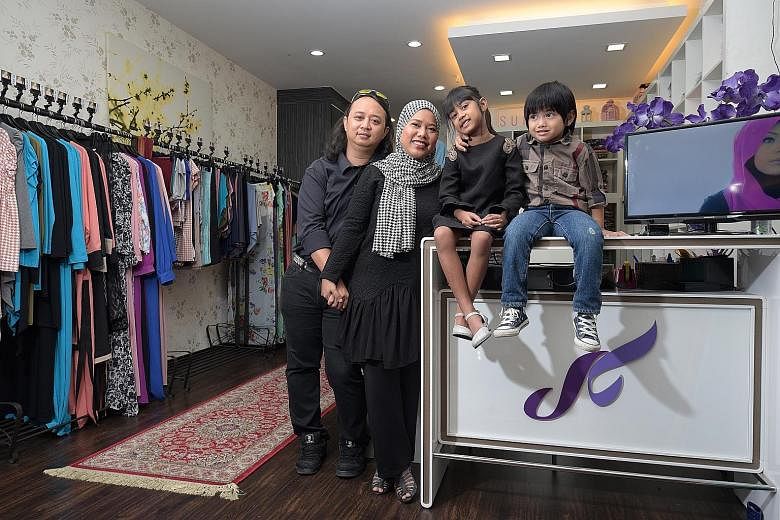When fashion entrepreneur Azrina Tahar was first setting up her business, she had no idea that the Mandarin she picked up at her previous job would come in handy.
The former draughtsman of 12 years had worked at the Housing Board, which sent her for Mandarin lessons, and then Surbana International Consultants.
The classes allowed Ms Azrina, 38, to communicate with staff at construction sites about architectural designs.
Now she employs the language to communicate with her manufacturer in China.
The founder of Sufyaa, a modest- clothing label for Muslim women, said: "In those 12 years, I spoke very simple, basic Mandarin, just trying to get people to do stuff and translating what we drew into words. I get by, but I still find the Chinese accents very thick."
In 2010, she started following her marine engineer husband Jasman Johari, 39, on his work trips to Hong Kong, looking for manufacturers and suppliers.
"I was expecting my son then, and fiddling with the idea of setting up the business. When I took maternity leave in 2011, I did not go back to my job at Surbana after the four months," she said with a laugh.
She wanted to spend more time with her daughter Sufia Jaide, now seven and whose name inspired the label, and son Wildan, four, and pursue her lifelong dream of being a designer.
With only $7,000, she knocked on doors but was turned down until she found a small factory, which she has since invested in, and her modest-clothing designs materialised for sale in 2011.
She started her business on Facebook and moved to the Netherlands with her husband for one year, but the turnover grew so fast that she had to return to manage and grow the business.
The savvy businesswoman was invited to operate a pushcart at Century Square in Tampines in 2012, where she was raking in "$1,000 on a bad day".
-
Worst and best bets
-
Q What has been your biggest investing mistake?
A Collections that don't work out because I didn't study the market. Never do that because it may not be what your customers want.
In fashion, if it doesn't move off the shelves, money's lost every day. I've lost about $70,000 to $80,000 a year. And also ordering more than what you should. It's difficult to foresee sometimes because I plan on collections three months in advance.
Q And what has been your best investment move?
A Investing in manufacturing. One of the main reasons I did so was to help the community.
I know how hard it is to start a brand or company because when I did... no one wanted to manufacture for me. I had no capital and no minimum order quantity. I told myself that in the long run, I want to help the community and whoever wants to start a business in fashion. Having my own production allows me to do that.
The next best investment would be the studio... It's open to all blogshops. I know how expensive it was to hire a photographer and models when I started.
Rachael Boon
That gave her confidence to set up a permanent shop space at a 35 sq m unit in Tanjong Katong Complex in 2012, and she has not looked back since.
She recalled: "In the first two years, I had no salary. I needed to break even and it was just about rolling back what I made to finance the business.
"I was fortunate that I had planned my finances after I left my job, and that was also why my husband took a job in the Netherlands."
Sufyaa hit a turnover of $1 million last year and now has another 80 sq m showroom and a new 100 sq m photography studio in Tanjong Katong Complex.
She invested in the studio to take professional photographs of Sufyaa's clothes in a bigger space and offer services to other businesses.
"Achieving my first $1 million turnover was amazing. The business grew from two to eight staff, I was just running the business from home, and to have two showrooms within five years, that's beyond my dreams," she said.
Sufyaa had broken even at the end of 2012 and Ms Azrina celebrated by getting herself a Rolex watch.
Her brand is going places too.
One of her career highlights was Sufyaa being the only Singapore name to be showcased at certain fashion shows, such as the London Muslim Expo in late August, the Jakarta Muslim Fashion Week last month, and the Moslema In Style International Fashion Forward show in Kuala Lumpur early this month.
Her ambition is to turn Sufyaa into a one-stop fashion house, with services ranging from manufacturing to photography and even providing consultancy services to budding fashion entrepreneurs.
"These days, you don't have to go into having an e-commerce site immediately. You can start on Instagram and so many other platforms. I invest in my business so I can have control over the clients I take in, and help blogshops and designers."

Q Moneywise, what were your growing-up years like?
A My mum was a single mother before she married my stepfather, who has died. It was tough growing up, my mum was a carpark attendant and I became very prudent and sensible with money. Both of us got by and she managed to buy a house for us.
Q How did you get interested in investing?
A When I first broke even, I knew I couldn't get by just through selling clothes. I needed to invest in something that would continue to let my business run and that was when I invested in the factory.
But foreigners aren't allowed to directly own businesses in China, so I couldn't invest more as it would be too risky, so I decided to invest in the next immediate plan, the photography studio.
Q Describe your investing strategy.
A I'm in an old shopping centre, but this is where my niche market is. All my competitors are here, but this is the place where customers come. I studied my market and the backend operations.
Muslims have two Hari Rayas and the Ramadan, which the whole year's sales depend on, and the festivities all happen here because of the bazaar.
It was part of my strategy to be here, so I didn't hold back on having two shops here rather than all over the place.
I also invested a lot in social media. I was lucky that when I started in 2011, Facebook was the most popular site and I garnered all my followers from there.
Investing in corporate social responsibility is also important. I work with several non-profit organisations, such as the Association of Muslim Professionals, to help cancer patients. I also work with voluntary welfare organisation Ain Society, where I help single mothers. They help me with part of the production of shawls.
I can't just be selling products to my customers, and you can give back in ways relevant to your business. I have to find strategies to stand out from H&M and Uniqlo. I mention them because they have just started their own modest-wear lines. They know money can be made in the industry.
Q What's in your portfolio?
A Besides the business, I have the $50,000 investment I made in the factory early this year. They invited me to invest and they moved to a bigger space with 10 people, so they've also grown with me.
My new investment is the studio. I've invested at least $10,000 in it - for another unit upstairs, the equipment and an in-house photographer. I'll move my online entity up to the new unit next month and all the photo-taking, editing, uploading will be done there.
Q What does money mean to you?
A It's still the key to success, but it comes with hard work. Hopefully, it brings a better future. With what I'm doing now, I hope it goes to my children.
When I started out, I wanted to create a sustainable business for my children. I read that in business, 80 per cent is mathematics - the business planning and funds you have - 10 per cent is luck and another 10 per cent is external factors.
I realised that it all boils down to money, and with what I produce I must make enough to cover my costs. I don't have to pay a third-party supplier but am spending more on raw materials and production.
Q What's the most extravagant thing you have done?
A I'm a very simple person, but it would be the luxury of travelling, taking my children out to see the world, sometimes exotic places. I make it a point to travel twice a year with my family.
My children have been fortunate enough to see the northern lights, or aurora borealis, in the Lapland area of Finland in 2013.
That was a dream come true for my husband and me. My girl has already travelled to 14 countries and she's only seven.
We've covered most of Europe.
Q What has been one of your biggest regrets when it comes to investing?
A Investing $10,000 to set up a graphic company early last year. It was called Sufyaa Designed and it lasted for six months.
But I learnt that that was not my forte. When I don't know the job scope, I can't be running it. I had to let go of two staff.
Q What are your immediate investment plans?
A I want to invest in my own production house, because I can't own the factory in China.
In recent weeks, I've been in Kuala Lumpur talking to people in production and they said it'll cost about RM500,000 (S$167,000) for a small-scale production like mine.
I previously sent over my designs to create samples in Malaysia and they launched my products a week before I planned to. The same thing happened in Indonesia.
In the long run, I want a production house to my name, under Sufyaa. It's a five-year goal.
Q Home is now...
A A maisonette in the east. I moved into it in 2013 from a four-room HDB flat. After my stepfather died, I wanted a place with four rooms for my own family, my mum and my helper.
Q I drive...
A An Audi Q5, which cost $253,000, and the certificate of entitlement was $80,000. It's really expensive now. The car is almost fully paid for.


